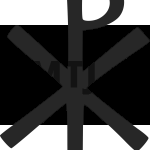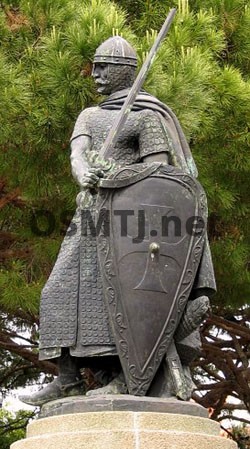IN HOC SIGNO VINCES
 The inscription on this stone (click picture on left to enlarge) was found at low tide after a major storm in April, 2010, along the beach in Newport, RI not far from the Newport Tower and Fort Adams, by Rhode Island resident Irene Daponte. The inscription reads, “IN HOC SIGNO VINCES,” which is a Latin phrase translating to, “In this sign we will conquer.” The slogan has been used by various military and religious groups over the centuries, including the Knights Templar. On the back side of the stone there are other markings which we have not yet identified, but one marking appears to be a Templar cross. The stone has since been reburied in the sand by the surf, but we have marked its location and will return to study it further when weather and tidal conditions allow.
The inscription on this stone (click picture on left to enlarge) was found at low tide after a major storm in April, 2010, along the beach in Newport, RI not far from the Newport Tower and Fort Adams, by Rhode Island resident Irene Daponte. The inscription reads, “IN HOC SIGNO VINCES,” which is a Latin phrase translating to, “In this sign we will conquer.” The slogan has been used by various military and religious groups over the centuries, including the Knights Templar. On the back side of the stone there are other markings which we have not yet identified, but one marking appears to be a Templar cross. The stone has since been reburied in the sand by the surf, but we have marked its location and will return to study it further when weather and tidal conditions allow.
Constantine, (280-337), on his march to Rome, before the battle at the Milvian Bridge, just outside the walls of Rome. At that decisive hour in his newly found faith, Constantine saw a vision in the afternoon sky: a bright cross with the words “By this sign conquer.” According to Constantine, Christ himself told him in a dream to take the cross into battle as his standard. Though accounts vary, Constantine apparently believed the omen to be a word from God. When he awoke early the next morning, the young commander obeyed the message and ordered his soldiers to mark their shields with the now famous Chi-Rho. Maxentius’s troops fled in disarray toward the surging Tiber. The would-be emperor attempted to escape over the wooden bridge erected to span the stream, but his own army-turned-mob, pressing through the narrow passage, forced him into the river, where he drowned by the weight of his armor. Constantine entered Rome the undisputed ruler of the West, the first Roman emperor with a cross in his diadem.
I had wrongly believed that “IN HOC SIGNO VINCES” was only for Masonic Templars to lay claim to. I soon learned from my Mentor, Grand Prior Luis Matos, that I was wrong. Fr. Luis explained that in the Templar Kingdom of Portugal, one of the most famous Templar Kings, King Alfonso Henriques, was praying the night before he would lead the Knights Templar on an attack on a Moors stronghold in Portugal. As he was praying, This Templar King saw a sign from God blazed across the sky as clear as day: “IN HOC SIGNO VINCES.” Full of confidence in Christ’s sign, the Templar King won a major victory the next day at the Battle of Ourique (July 25th, 1139, the forces of Portuguese Afonso Henriques defeated the Almoravid Moors led by Ali ibn Yusuf). Read more about it here: http://www.traditioninaction.org/History/A_014_BirthPortugal.htm
 The cross sign Constantine referred to was a kind of ‘X’. During the medieval period in Europe, many of the Knight’s Templar had their legs crossed in the casket to represent Constantine’s Cross.’ (page 156, Dark Majesty, Texe Marrs). Many of the Knight’s Templar gravestones now stored in various Abbeys in Scotland have the skull with the crossed leg bones below it in representation of Constantine’s cross.
The cross sign Constantine referred to was a kind of ‘X’. During the medieval period in Europe, many of the Knight’s Templar had their legs crossed in the casket to represent Constantine’s Cross.’ (page 156, Dark Majesty, Texe Marrs). Many of the Knight’s Templar gravestones now stored in various Abbeys in Scotland have the skull with the crossed leg bones below it in representation of Constantine’s cross.
Source: http://westfordknight.blogspot.com/2011/01/new-newport-inscription.html


